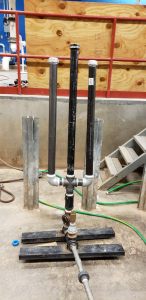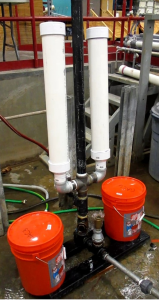By Arcelia Mendoza, 915-204-2174, arcym@nmsu.edu
Date 06/16/2020
Due to the Coronavirus pandemic, a project of nearly a year in the making to provide residents of Oyanca, Nicaragua with potable water continues from New Mexico State University, with hope of finishing the on-site work next summer. Engineering Technology Professor Kenny Stevens and a group of NMSU students are working to increase the amount of water that hydraulic ram pumps deliver for the NMSU.
|
|
 |
| |
|
Students from New Mexico State University’s Aggie Without Limits have been working to improve the efficiency of hydraulic ram pumps to provide residents of Oyanca, Nicaragua with potable water. Pictured here is the original ram pump with steel air chambers. (NMSU photo by Kenny Stevens) |
Stevens, a licensed civil engineer and former Peace Corps volunteer, has spent years researching how to improve the efficiency of hydraulic ram pumps, a type of pump that does not need an external power source (such as electricity or gasoline), which makes them ideal for developing communities. The students who will be assisting Stevens are members of Aggies Without Limits, a nonprofit NMSU student organization that takes on local and international students service projects.
“Oyanca and Potrero didn’t have electricity until about three years ago,” Stevens said. “Now, about 80 percent of the houses have it, about 60 percent of the houses have potable water. The ram pump will get it to another 25 to 30 percent.”
The improvement project is meant to produce “an efficient, reliable and practical hydraulic ram pump capable of pumping spring water to a water reservoir tank that would be distributed to approximately 100 people in the village of Oyanca,” said Lucas Rivera, a civil engineering major and the project manager of Aggies Without Limits.
Aggies Without Limits members selected the group because it met their mission statement: “To bring students, faculty members together to improve the daily lives of developing communities through sustainable infrastructure.” Rivera added that the group also selected Oyanca because they believed they could do the most good for the greatest number of people.
The hydraulic ram pump works using just gravity, Stevens explained. The water from a source such as a river or spring goes down the metal feed pipe to a check valve. The check valve has an opened flap inside that closes if the water gets flowing fast enough. When the flap closes, it sends a small shock wave up to the chambers (tanks) that store air. As the air compresses them, it pushes the water up the delivery pipe connected to a water reservoir. To stop the water from coming back, another check valve is under the air chambers, which closes when the shock wave passes through the system. Then, the first valve, feeling the initial pressure released, reopens to repeat the process.
Stevens started this research project as a graduate student in the 1990s, building a hydraulic ram at home to see how it worked. The story of its accidental discovery fascinated him. During the 1850s, an indoor plumbing system of a hospital in England couldn’t elevate water to the third floor for a surgeon doing procedures.
“The surgeon sent the nurse to bring buckets of water from the basement,” he said. “The nurse was so angry that he/she kept slamming the valve shut as he/she filled the buckets. Every time the nurse slammed the water valve shut, a spurt of water made it to the third floor. From then on, the surgeon had the nurse go to the basement and just open and close the valve continuously to get ‘spurts’ of water to the third floor.”
To simulate the nurse’s actions, people added air chambers and check (flapper) valves to make the system more automatic. However, the ram pump’s developments came from individuals’ attempts to see if the ram worked better or not without any specific reasons or calculations.
“After more than 100 years, nobody really knows why the ram pump actually works the way it does,” Stevens said. “Previous studies say [a] bigger [air chamber] is better, but without any quantitative numbers. We are trying to get those numbers.”
|
|
 |
| |
|
Students from New Mexico State University’s Aggie Without Limits have been working to improve the efficiency of hydraulic ram pumps to provide residents of Oyanca, Nicaragua with potable water. Pictured here is the student’s redesign of a more efficient ram pump with PVC air chambers. (NMSU photo by Kenny Stevens) |
Lucas Grey, a mechanical engineering technology major, has worked on ram pump improvements for his senior project. The original hydraulic ram had only one long air chamber, he said. His research found that the larger the air chamber, the higher the efficiency of a ram pump. A big air chamber is expensive for developing communities, he said.
“Therefore, if there is a cross attached to the bottom of the tank, then there would be room for two more tanks of the same size,” Grey said in his research report. Such an engineering adjustment would reduce the price of a larger tank, while still increasing the amount of air that fits inside the two chambers.
Grey’s research led Stevens to swap out two black metal air chambers (pipes with lids) for two white plastic PVC chambers (pipes) three times bigger. The efficiency increased by 1.1 percent, according to Stevens’ measurements.
“This project is important because being able to use engineering to help developing countries is a very important cause to help those in need,” Grey said. “Increasing the efficiency of this ram will help transport more clean water to areas in need, therefore helping more people.”
Rivera and civil engineering technology major Damion Fragoso are currently working to determine the size requirements for the Oyanca ram pump project.
“With his [Stevens’] advising, students within Aggies Without Limits are able to research ways to improve upon developed hydro-ram theories,” Rivera said, “and design a water system that will meet the needs of the local being visited this summer.”
Although the Coronavirus outbreak forced a change in plans, Stevens and his students are hoping to travel to Nicaragua in the summer of 2021. Stevens and the students are still working with the Oyanca to keep the project going by advising them on materials and parts that they will need for the project via the internet.
In the meantime, they are working on some local projects. They are helping to design and build a bridge for the Otero County Fairgrounds so that attendees can go from the display area to the midway without going into the street. Currently, the two areas are separated by an arroyo that prohibits crossing directly.
They will also continue working on a project that began in summer 2016, when Aggies Without Limits partnered with Foxhole Homes, in Alamogordo to help establish a group for homeless veterans. Foxhole Homes is currently concentrating their efforts on using compressed tire bales for construction purposes. Assuming the permitting process continues as planned, AWL will help with the construction of the first such building in southern New Mexico.
AWL is composed of students from all colleges in NMSU, not just engineering. They cover all the expenses of their projects through fundraisers and donations. For more information, visit: https://aggieswithoutlimits.org.


